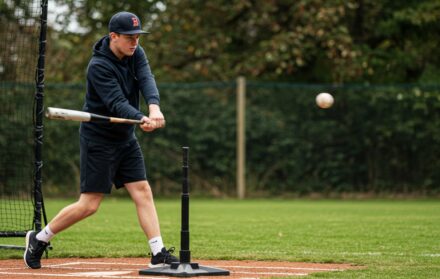
How to Hit a Baseball for Beginners?
Learning how to hit a baseball for beginners can seem overwhelming at first, but with the right mindset and proper guidance, you’ll soon discover the thrill of making solid contact at the plate. When you understand the rules of baseball, develop a stable stance, and follow consistent practice routines, you’re already on your way to becoming a more confident hitter. It all starts with breaking down the basic components of batting: from gripping the bat correctly, to syncing your swing with the ball’s trajectory, to honing your mental focus.
In the history of baseball, legendary sluggers mastered these same fundamentals, paving the way for future generations of players to refine batting techniques even further. For baseball for beginners, the secret lies in continuous repetition, mental preparation, and an eagerness to learn from both successes and failures. Equipping yourself with knowledge from a baseball equipment guide also ensures you’re choosing the right bat length, weight, and gear to maximize your performance.
Throughout this article, you’ll discover practical baseball training tips, detailed breakdowns of the batting process, and strategies for overcoming common mistakes. Whether your goal is to join youth baseball leagues, impress on a weekend game, or simply understand how to play baseball more effectively, these fundamentals will support your growth. By consistently working on stance, grip, timing, and adaptability, you’ll build the confidence and skillset needed to handle various baseball pitching techniques. With patience and the right approach, you’ll see improvement in both contact and power, transforming your experience at the plate into one of success and excitement.
Establishing the Ideal Batting Stance for Baseball Hitting Drills

A proper stance is a crucial aspect of baseball for beginners because it directly influences balance, power, and accuracy. Start by placing your feet shoulder-width apart, keeping them parallel so you can shift weight smoothly during your swing. Slightly bend your knees to create a stable yet flexible base, which allows you to pivot quickly in response to the pitch. This emphasis on stability is why many top baseball teams prioritize stance refinement in their baseball hitting drills and practices.
Next, align your shoulders in a relaxed but alert position. Tension in the upper body can hinder fluid movement, so it’s important to maintain comfort while staying prepared to rotate. Focus your gaze toward the pitcher, ensuring you can follow the ball from the moment it’s released. Keeping the right posture will let you capitalize on any incoming pitch, whether it’s a fastball or a breaking ball.
Finally, remember that stance also involves mental preparedness. In Major League Baseball (MLB), star hitters often visualize successful contact before stepping into the batter’s box, which helps them stay composed under pressure. Developing this mental habit is beneficial at any level, from youth baseball leagues to high-stakes games. A well-practiced batting stance aligns your body mechanics and mental focus, setting you up for effective swings and consistent hitting results.
Perfecting the Bat Grip Using Baseball Coaching Tips
Gripping the bat correctly is a fundamental step that ties directly into overall hitting performance. Begin by placing your dominant hand near the bottom of the bat handle, with your non-dominant hand stacked just above it. Ensure your knuckles line up, promoting a more efficient swing path as the bat moves through the baseball field dimensions. Many baseball coaching tips stress how an aligned grip can significantly improve accuracy and reduce unwanted twisting of the bat upon impact.
Maintain a firm but not overly tense hold on the handle. A vice-like grip restricts your wrists and can decrease bat speed, while a grip that’s too loose undermines control. The key is to remain in a state of readiness—your hands should feel both secure and flexible, capable of adjusting quickly to varying pitch speeds or locations. This balance mirrors the approach seen among famous baseball players who adjust their grip pressure depending on whether they’re seeking contact or aiming for power.
Additionally, treat each pitch as an opportunity to refine your grip awareness. If you find yourself fouling off too many pitches or missing them entirely, reassess how you hold the bat. Make small adjustments and observe improvements in your swing. Over time, this process becomes second nature, forming the foundation for consistent performance. It’s a small detail, yet mastering the grip is often the turning point for hitters looking to elevate their game.
Keeping Your Eye on the Ball: A Core Aspect of How to Play Baseball

The classic advice to “keep your eye on the ball” might sound simple, but it remains one of the most critical facets of how to play baseball effectively. The moment the pitcher starts the wind-up, lock your focus on the ball. This unwavering concentration is vital for identifying pitch speed, spin, and location—factors that directly influence your timing and contact point.
To enhance this skill, engage in regular baseball drills for kids or adult batting sessions where you focus solely on tracking. Over time, your eyes become more adept at reading the pitcher’s release, which can reveal hints about what type of pitch is on the way. This skill is especially useful when facing various baseball pitching techniques, such as fastballs, curveballs, and sliders, each demanding nuanced adjustments in swing speed and angle.
Building strong hand-eye coordination also benefits your confidence. When you trust that you can see the ball clearly, you’ll swing with more conviction. This shift in mindset helps prevent second-guessing at the plate, a common pitfall for beginners. By consistently keeping your gaze fixed on the ball, you’ll lay the groundwork for more refined batting results and a sharper competitive edge.
Timing Your Swing with Baseball Terminology Mastery
Effective hitting is heavily influenced by baseball terminology related to timing, such as “load,” “stride,” and “follow-through.” Understanding these concepts enables you to merge footwork and body rotation in a seamless way. The loading phase involves shifting your weight onto your back leg right before the pitcher releases the ball, creating stored energy that translates into bat speed.
During your stride, move your front foot slightly forward while keeping your head steady and eyes on the target. This controlled step helps maintain balance and aligns the body for optimum contact. Many baseball training tips highlight how timing the stride with the pitcher’s motion is pivotal to achieving a powerful, well-placed hit.
Finally, the follow-through stage completes your swing. Let your hips rotate fully and your hands continue their path after hitting the ball. Think of it as a natural extension rather than a forced action. This final motion not only adds power but ensures you’re finishing strong on every swing. By becoming fluent in these essential baseball terms and syncing them with your body’s actions, you’ll significantly boost your ability to connect with the pitch.
Generating Power and Contact Through Baseball Hitting Drills
Generating true power isn’t about muscling through the swing; rather, it revolves around coordinated body movements. When you harness lower-body strength and seamlessly transfer energy from your legs to your core and upper body, you create the torque needed for a dynamic hit. Many baseball hitting drills focus on rotational exercises to develop this synergy, helping you learn how to rotate the hips and torso for maximum impact.
Consistent practice off a batting tee or through soft-toss sessions refines this power transfer. These controlled drills help you isolate specific aspects of the swing, from hand positioning to hip rotation. Over time, you’ll build muscle memory, enabling you to instinctively merge power with finesse in game situations. The idea is to channel your entire body’s energy toward the ball rather than relying solely on the arms.
Equally important is making proper contact. Focus on the sweet spot of the bat, typically a few inches from the end of the barrel. When the bat meets the ball correctly, even a moderately powered swing can send the ball flying. This accuracy is often what separates hitters who constantly get on base from those who struggle with consistency. By dedicating time to skill-specific drills, you reinforce both power and precision, forming a cohesive approach to hitting.
Adjusting to Various Baseball Pitching Techniques for Baseball for Beginners

Encountering diverse pitches can be daunting for baseball for beginners, but adapting quickly can elevate your batting success. Fastballs demand a quicker reaction, while curveballs and sliders often require a more measured approach. Observing the pitcher’s grip and release point can reveal early clues about the pitch type. This anticipation helps you decide whether to shorten your swing or wait an extra split-second before making contact.
A productive way to refine this skill is by studying famous baseball players known for their adaptability at the plate. Learn how they track the ball, watch for subtle hints from the pitcher, and adjust their swing path mid-motion. Recreating these techniques in practice, whether through live pitching or machine setups, sharpens your response to varying speeds and angles.
Another factor in handling different pitch types is maintaining composure. Even elite hitters occasionally misread pitches or strike out. The key lies in calmly analyzing what went wrong and adjusting for the next at-bat. Confidence coupled with adaptability creates a hitter who can handle whatever the pitcher throws, ensuring you remain a threat no matter the count or the situation.
Mental Preparedness and Baseball and Pop Culture Influences
Beyond physical skills, the mental aspect of hitting plays a substantial role in batting success. Many best baseball movies and highlights in baseball and pop culture showcase sluggers who exude confidence under high-pressure moments. This mindset stems from disciplined mental conditioning: visualizing successful swings, reviewing past at-bats, and focusing on incremental progress rather than instant perfection.
Staying relaxed in the batter’s box is paramount. Excess tension can make you lunge at the ball prematurely or cause your body to tighten, spoiling your form. Practicing breathing exercises or employing quick mental resets before each pitch can keep nerves in check. This composure is especially vital during intense matchups, like a rival game or a late-inning scenario where a big hit can turn the tide.
Additionally, leveraging baseball statistics explained by coaches or mentors allows you to set informed goals and track improvements. Understanding data like on-base percentage or slugging percentage can pinpoint areas needing extra attention in practice. Balancing the mental game with a strong grasp of your stats positions you for continued development. Ultimately, you’ll combine confidence, focus, and self-awareness to become a more formidable presence in the lineup.
Common Mistakes, Baseball Injuries and Prevention, and Long-Term Growth
Beginners often fall into traps that derail progress, such as repeatedly swinging for the fences or letting self-doubt creep in after a few missed pitches. Over-swinging can cause poor balance and reduced contact, while negative thoughts might prompt hesitation or second-guessing. Recognize these pitfalls early and develop strategies—like consistently practicing with a batting tee or focusing on contact rather than power—to move beyond them.
Physical well-being also plays a pivotal role in batting success. Baseball injuries and prevention methods often highlight proper warm-up routines, sufficient rest days, and correct exercise form to avoid strain on shoulders and elbows. Even the best batting mechanics suffer if you’re dealing with nagging injuries or chronic discomfort. Consult with coaches or medical professionals when necessary to keep your training on track.
Long-term growth hinges on patience and persistence. Consistently evaluate your progress, celebrate small victories, and learn from setbacks. As you gain experience, consider exploring advanced realms like fantasy baseball tips, baseball card collecting, or analyzing World Series history to deepen your appreciation for the sport. Each new skill or piece of knowledge can enrich your overall playing experience, making the journey of becoming a proficient hitter all the more rewarding.
Conclusion on How to Hit a Baseball for Beginners

Mastering how to hit a baseball for beginners is an ongoing journey that merges physical skill with mental preparedness. By focusing on fundamentals like a strong stance, proper grip, keen observation of the ball, and precise timing, you lay the groundwork for consistent improvement. Alongside these basics, don’t overlook the power of mental resilience—visualizing successful contact, staying composed under pressure, and learning from each at-bat help transform raw potential into real results. Whether you’re aiming for youth baseball leagues or dreaming of a future in Major League Baseball (MLB), the right blend of technique and determination can take you far.
Approach each practice with clear objectives, using baseball training tips and structured drills to refine every aspect of your swing. Adaptability is also paramount: as you gain experience facing various baseball pitching techniques, you’ll learn to react effectively, adjusting your stance or timing to meet the demands of different pitches. Many famous baseball players have honed their craft by diligently studying and emulating proven methods, recognizing that a well-rounded skill set is essential to success at any level of competition.
Finally, remember that hitting is just one piece of the broader baseball for beginners experience. Immerse yourself in the culture by exploring baseball and pop culture, supporting your favorite top baseball teams, and staying updated on events like World Series history. Embrace opportunities to connect with fellow fans, don baseball fan gear, and learn about the sport’s rich legacy in places like the Baseball Hall of Fame. Combining passion, consistent practice, and an open mind will elevate your growth, ensuring that every time you step into the batter’s box, you bring both confidence and excitement to the plate.





